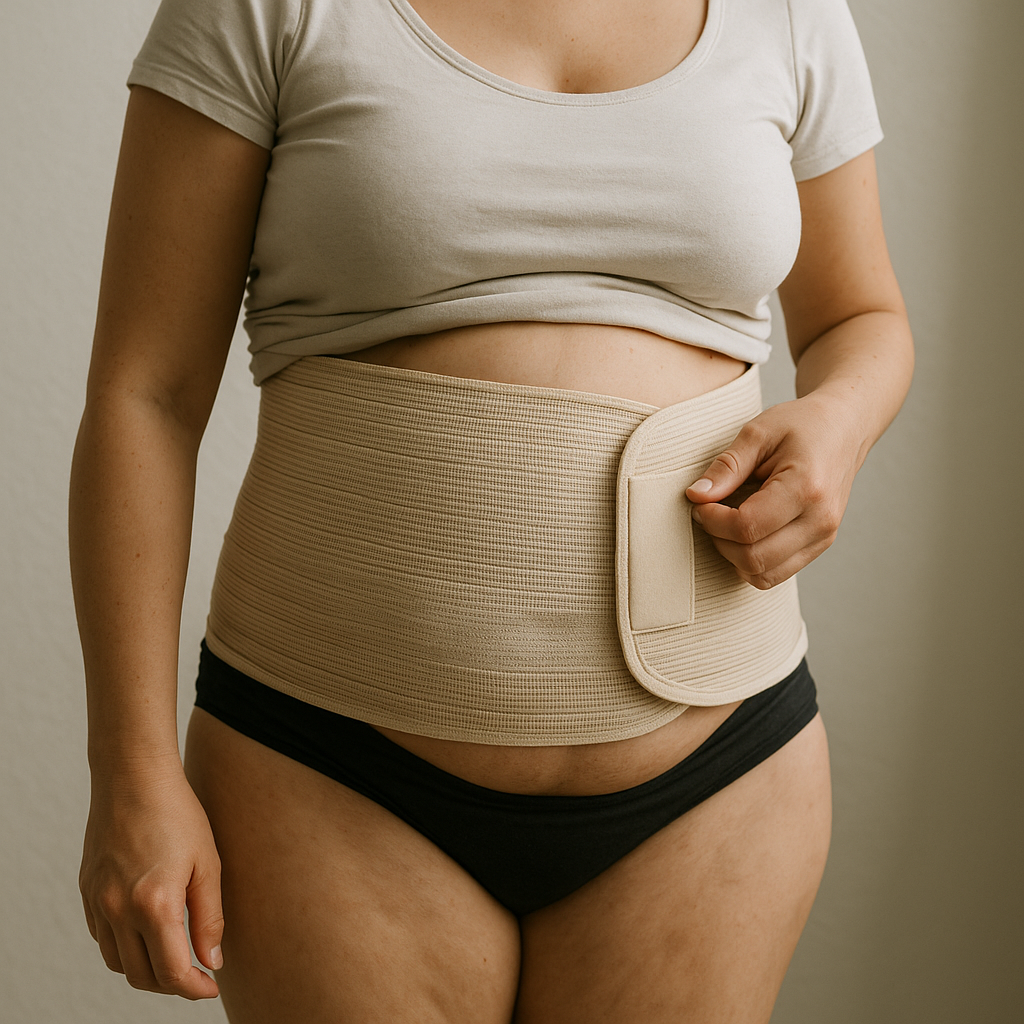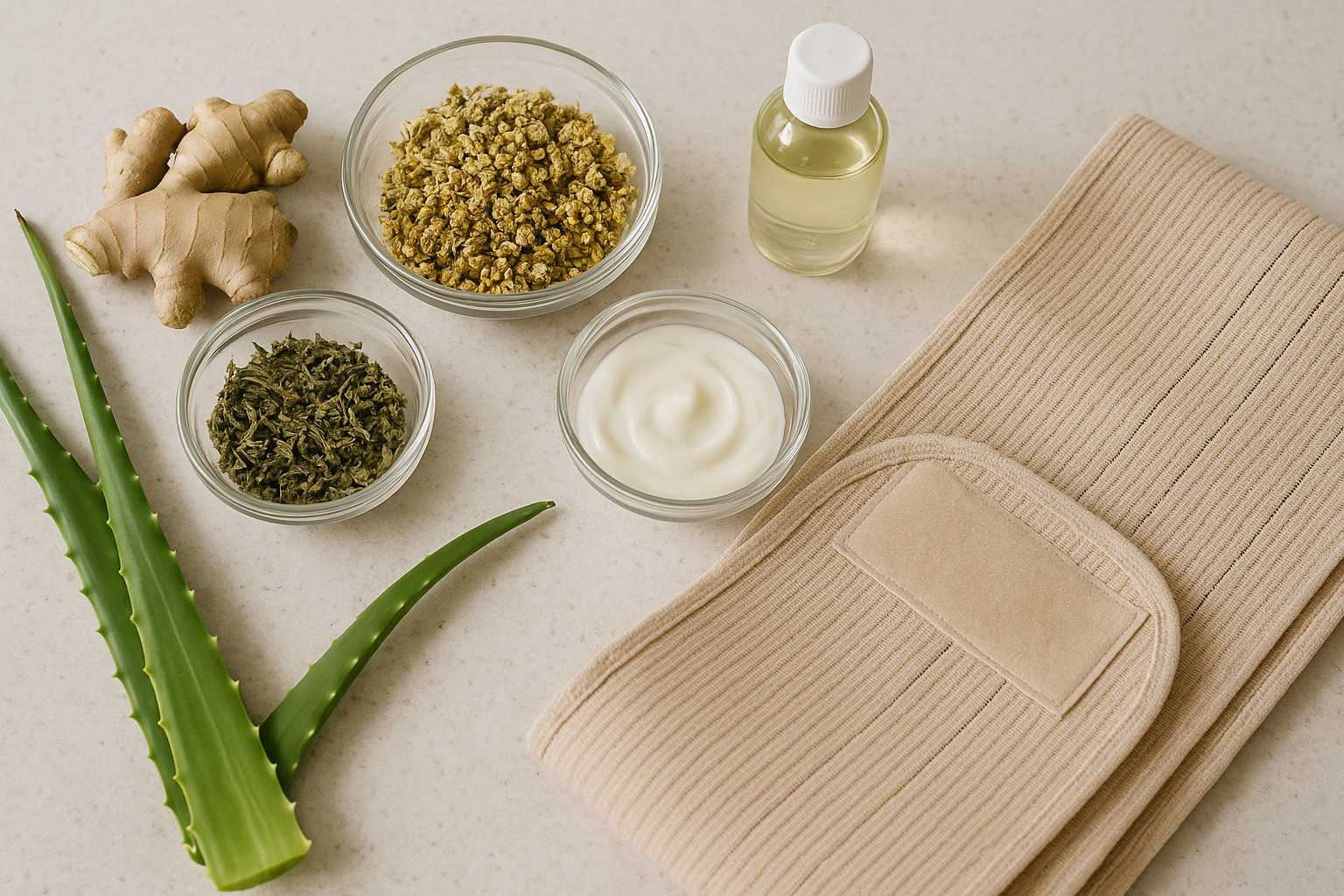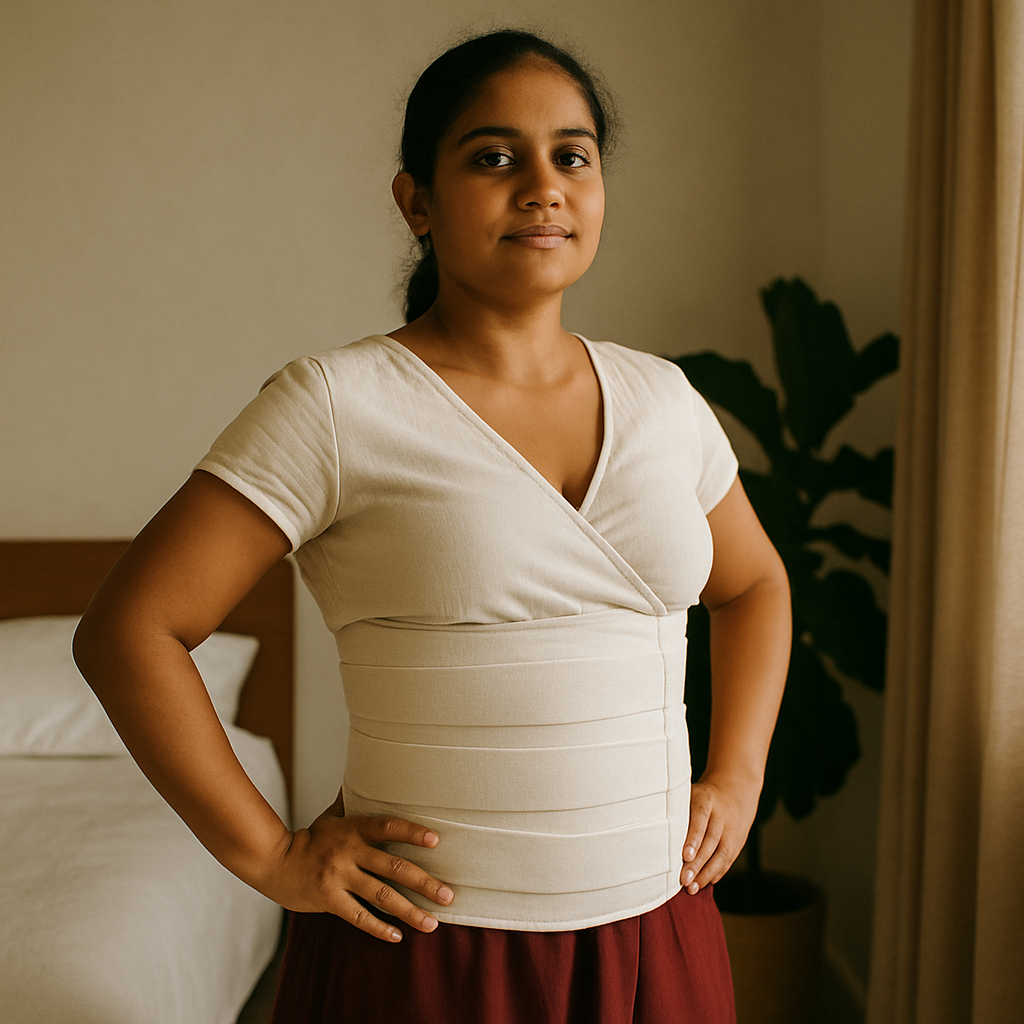Ask Ayurvedic doctor a question and get a consultation online on the problem of your concern in a free or paid mode. More than 2,000 experienced doctors work and wait for your questions on our site and help users to solve their health problems every day.
Shop Now in Our Store
Abdominal Binder After Delivery: A Deep-Dive into Ayurvedic Wisdom

Introduction to Abdominal Binder After Delivery
Okay, let’s start with the obvious: childbirth changes everything. Your body, your emotions, your priorities — all of it. And right after delivery, whether natural or C-section, you’re often left wondering: Will I ever feel “put back together” again?
That’s where the humble abdominal binder after delivery comes in — not just as a modern maternity aid but, if we rewind a bit, as something deeply rooted in Ayurvedic postpartum care.
In Ayurveda, the phase after delivery is sacred — it’s called Sutika Kala, and the body is seen as vulnerable yet highly responsive to healing. The abdominal area, especially, is considered a seat of Vata dosha, which tends to go haywire after childbirth (cue: bloating, dryness, instability — physical and mental).
Now, imagine a wide cloth wrap — snug but not suffocating — that gently hugs your belly, helps your uterus shrink back, supports your core, and even keeps that unpredictable Vata in check. That’s what the abdominal binder or "katcha" was originally meant to do.
In modern times, you’ll find stretchy Velcro versions at maternity stores, but in Ayurveda, it’s more than a postpartum accessory. It’s part of a whole healing system — a rhythm of oil massages, warm foods, herbal decoctions, and yes, abdominal binding.
This article is for you if:
-
You just gave birth (or are planning to) and feel overwhelmed by recovery.
-
You’re curious how Ayurveda looks at the postpartum body.
-
You’ve heard of belly wraps and want more than just surface-level info.
-
You’re skeptical — and want real insights before trying anything.
We’re going deep: the history, the logic, the procedures, the dos and don’ts, the benefits — even what the old Ayurvedic texts say. And we’ll weave in some side-notes, opinions, stories, and practical wisdom along the way.
So grab a warm drink, cozy up, and let’s dive in.

History and Origin of Abdominal Binder After Delivery
Historical Background and Roots of Abdominal Binder After Delivery
Let’s go back a few centuries — maybe even millennia. Picture a mud hut in a quiet Indian village, the sweet scent of sesame oil in the air, and a newborn wailing in the corner. A woman — recently delivered — lies resting, her belly wrapped tight with a long, handwoven cotton cloth. Not for fashion. For function. For healing.
Abdominal binding after childbirth wasn’t a “tip” from an online mom’s group. It was tradition. It was protocol.
This practice — known by various regional names like Katcha, Udarbandhan, or Peetambar — has been part of postpartum routines in ancient Indian, Middle Eastern, African, and Southeast Asian cultures. The idea? Stabilize the core, reduce internal pressure, help the uterus return to size, and prevent prolapse or hernias. And maybe even tone the body — although that wasn’t the primary goal back then.
In India specifically, the binder was usually a long piece of muslin or cotton cloth (think 5 to 10 meters), wrapped around the torso from just under the breasts to the pelvic area. No stretchable elastic. No hooks or zippers. Just a snug wrap — tied by hand, often with the help of a midwife.
The logic? It mimicked the support the abdominal muscles had during pregnancy and gave the now-empty womb a chance to contract inward, naturally and safely.
Ayurvedic Textual References About Abdominal Binder After Delivery
Now here’s where it gets even more fascinating — Ayurvedic classics mention the practice, albeit not always by the name we use today.
In the Charaka Samhita and Ashtanga Hridaya, postnatal care is given a dedicated space. There’s emphasis on bandhana (binding) after snehanam (oil application) and swedana (sudation or steam therapy). The texts describe the woman as being in a delicate Vata-aggravated state, requiring both internal and external stabilizing methods.
The idea of “Udar-bandha”, or binding the abdomen, is said to:
-
Provide structural support to loosened abdominal muscles,
-
Aid uterine involution,
-
Prevent displacement of pelvic organs,
-
Reduce lower back strain and discomfort.
While the language is old, the wisdom is surprisingly modern.
And just to clear up confusion — Ayurveda doesn’t promote rigid corseting or tight compression. The binder should be supportive, not restrictive. There’s a big difference.
Traditional Use and Evolution of Abdominal Binder After Delivery
Traditionally, the abdominal binder was applied daily for the first 40-45 days postpartum, sometimes even longer depending on the mother’s strength and recovery. It was one piece of a larger recovery puzzle — which also included:
-
Daily Abhyanga (oil massage) with warm, herbal oils.
-
Herbal decoctions to tone reproductive tissues.
-
Rest in a warm environment — no fans! as the elders would say.
-
Soft, nourishing foods — mostly rice, ghee, and moong dal.
Over time, as hospital births became the norm and nuclear families replaced joint ones, many of these rituals got dropped — including binding. Some women found it too fussy, some just didn’t have help, and others were told it was “old-fashioned.”
But now? It’s slowly making a comeback — with modern moms Googling “should I wear a belly wrap after delivery?” and getting lost in a sea of conflicting advice.
That’s why this conversation — steeped in both tradition and inquiry — matters more than ever.
Purpose and Benefits of Abdominal Binder After Delivery
Physical Health Benefits of Abdominal Binder After Delivery
Let’s be honest: after delivery, your belly can feel like an alien landscape. Squishy, unsupported, kind of… floating. That’s not just a feeling — your abdominal wall is literally weakened, your uterus is still enlarged, and your organs are reconfiguring themselves. So yeah, your body needs help — and not in the “snap back” Instagram way.
Enter the abdominal binder.
In Ayurveda, this wrap is more than external scaffolding. It’s a way to hold the body in integrity during one of its most open, fragile stages.
Here’s what the binder physically supports:
-
Uterine Involution – It helps your uterus shrink back faster and more safely.
-
Muscle Realignment – It gently encourages the rectus abdominis (yep, those “abs”) to come back together, especially if you have mild diastasis recti.
-
Spine and Posture Support – With the body off-balance and exhausted, the binder acts like a backup team for your core.
-
Post-Cesarean Recovery – While Ayurveda leans toward natural birth, for C-section moms, a binder can reduce pain from movement and support the healing incision.
And no — it’s not a weight loss tool. That’s a modern misinterpretation. Binding is about support, not slimming.
Mental and Emotional Benefits of Abdominal Binder After Delivery
Now here’s the part no one tells you: postpartum isn’t just about your body, it’s about your mind. The Ayurvedic lens sees the mind as closely linked to the Vata dosha — which governs movement, change, nervous energy.
After birth, Vata goes wild. You feel:
-
Scattered.
-
Vulnerable.
-
Anxious, sometimes without reason.
-
Like your spirit is floating outside your body.
A belly wrap, oddly enough, helps. It grounds you. Like a firm hand on your lower back saying, “You’re safe. You’re held.”
I’ve heard new mothers say it gave them a surprising sense of calm. Like swaddling for adults. There’s something about being wrapped — gently but firmly — that can help settle an agitated nervous system. Ayurveda understands this in energetic terms. Modern science might call it somatic regulation.
Either way, it works.
How Abdominal Binder Balances the Doshas (Vata, Pitta, Kapha)
Ah, the three doshas — Ayurveda’s favorite trio.
Let’s break down how the binder influences them:
-
Vata (Air + Ether): This is the big one. Binding contains Vata, which tends to scatter and rise postpartum. It soothes instability, lightness, and dryness — hallmarks of high Vata.
-
Pitta (Fire + Water): If binding is done too tightly or with hot synthetic materials, it can overheat Pitta. That’s why breathable cotton and correct technique matter. When done right, it keeps Pitta calm and avoids inflammation.
-
Kapha (Earth + Water): The binder offers structure, which Kapha already has — so not much change here. But if Kapha is sluggish postpartum (e.g. slow digestion, congestion), the binder can sometimes feel too heavy or restrictive. In those cases, lightening therapies are paired with it.
Balance is the keyword. The binder doesn’t work in isolation — it works as part of a tailored Ayurvedic plan.
Detailed Procedure and Steps of Abdominal Binder After Delivery
Preparation for Abdominal Binder Procedure
Before you even touch the binder, there’s a rhythm to Ayurvedic postpartum care. The sequence matters:
-
Abhyanga (oil massage) – ideally with warm sesame or Bala oil.
-
Swedana (mild sweating) – often using a warm cloth or herbal steam.
-
Rest and hydration – warm herbal teas or decoctions.
-
Then comes the binder — not cold, not abrupt.
The idea is to make the body supple and receptive before wrapping it.
And materials? Go natural. Ayurveda recommends:
-
Soft, washed cotton or muslin cloth.
-
About 6–10 meters in length.
-
No synthetic fabrics, no tight elastic belts.
Step-by-Step Guide of Abdominal Binder Procedure
Let’s walk through the actual steps. I’ll keep it real — this can feel awkward at first, especially if you’re doing it solo.
1. Choose the right time:
Morning, after bathing and Abhyanga, is ideal.
2. Lie flat on a firm surface:
This helps align the spine and allows for uniform wrapping.
3. Start wrapping from the pelvic area upward:
Not under the bust — that can restrict breathing. Just below.
4. Wrap snugly but not tightly:
You should feel supported but able to breathe and sit comfortably.
5. Tuck or tie the ends securely.
Traditionally, it’s tied at the side or back using a knot or pin.
6. Move around a bit.
Make sure it stays in place. Readjust if needed.
Note: In cases of C-section, consult your doctor or Ayurvedic practitioner. Binding should never put pressure on a fresh incision.
Duration and Frequency Recommendations for Abdominal Binder
There’s no universal rule, but here’s what traditional Ayurvedic postpartum experts recommend:
-
First 7–10 days: Use daily for short periods (1–3 hours), allowing the body to adapt.
-
Next 30–40 days: Up to 6 hours per day, ideally during waking hours.
-
Beyond 6 weeks: Use as needed — some women find comfort wearing it for months.
The body should lead the decision. If it feels too tight, heavy, or irritating — pause. Ayurveda always adapts to the individual.

Herbs, Oils, and Ingredients Used in Abdominal Binder After Delivery
Key Herbs and Oils Essential for Abdominal Binder
Technically, the binder itself doesn’t contain herbs. But what you apply before binding — especially as oil — is crucial.
Here are some of Ayurveda’s go-to postpartum oils:
-
Bala Taila – Strengthens muscles and nerves.
-
Dhanwantharam Taila – The superstar of postnatal care, supports recovery and Vata balance.
-
Ksheerabala Oil – Especially good if there’s sensitivity or weakness.
-
Castor Oil – Used sparingly for deep muscular relief.
-
Sesame Oil (Tila Taila) – The classic base, warming and nourishing.
These are often infused with herbs like:
-
Ashwagandha – Restorative, helps fatigue.
-
Shatavari – Reproductive tonic.
-
Dashamoola – Anti-inflammatory and grounding.
Benefits and Roles of Specific Ingredients in Abdominal Binder
You’re not just slathering on oil for moisture. These ingredients play real roles:
-
Ashwagandha – calms nerves, builds strength.
-
Bala – restores muscle tone and function.
-
Dashamoola – reduces internal swelling.
-
Ginger and fennel oils (sometimes added) – help with digestion and bloating, which are common after delivery.
Think of the oil as the herbal delivery system. The binder then holds it in — like wrapping a poultice around your midsection.
Where and How to Source Quality Ingredients
Honestly? Not all Ayurvedic oils are created equal. Some mass-produced versions are diluted or synthetically perfumed.
Here’s how to spot a good one:
-
Buy from trusted Ayurvedic pharmacies (like Arya Vaidya Sala, Kottakkal, or Vaidyaratnam).
-
Look for handmade or small-batch oils — these often stick closer to classical methods.
-
Avoid products with too many preservatives or unknown chemicals.
Your skin is your biggest organ — treat it like one.
Indications and Contraindications for Abdominal Binder After Delivery
Health Conditions and Symptoms Indicating Abdominal Binder
Binding isn't just a generic recommendation. It’s indicated when certain conditions are present:
-
Excessive looseness or sagging of the abdomen
-
Mild uterine prolapse
-
Post-C-section weakness (only after initial healing)
-
Lower back pain
-
Sense of instability or “emptiness” in the core
-
Mild diastasis recti (not severe splits)
Even emotional signs like anxiety, restlessness, or difficulty grounding — all signs of Vata imbalance — may signal the need for binding.
Potential Risks and Contraindications of Abdominal Binder
Let’s not pretend it’s risk-free. Ayurveda is personalized medicine — and binding, if done wrong, can backfire.
Avoid or use with caution if:
-
You have severe C-section scarring or infections.
-
You experience breathing difficulty or gastric discomfort during binding.
-
You’re extremely Pitta-dominant and prone to overheating.
-
You have skin sensitivities or allergies to fabrics/oils.
Too tight = too dangerous. A binder should support, not compress.
Who Should Avoid Abdominal Binder or Seek Expert Advice
Not everyone is a good candidate, and that’s okay. Consult your Ayurvedic practitioner or midwife if you:
-
Had a complicated birth or multiple C-sections.
-
Have hernias, especially umbilical or inguinal.
-
Experience sharp or unexplained abdominal pain.
-
Have a history of hypertension or circulatory disorders.
The takeaway? Don’t do it just because it’s trending. Ayurveda says: know thy prakriti (constitution), and proceed mindfully.
Aftercare and Post-procedure Recommendations for Abdominal Binder After Delivery
Recommended Lifestyle Adjustments After Abdominal Binder
Alright, so you’ve wrapped your belly — what now?
In Ayurveda, healing isn’t a one-trick pony. Binding works best when supported by a lifestyle that honors recovery, not rushes it.
Here’s the general vibe:
-
Warmth is life – stick to warm clothes, warm rooms, and no cold drafts. Your belly’s not just healing; it’s re-learning how to hold your organs together.
-
Rest isn’t laziness – in fact, Ayurveda recommends at least 42 days of rest (Sutika Paricharya) after birth. You’re not “doing nothing.” You’re healing.
-
Avoid overexertion – skip stairs, lifting, intense movement. The binder helps, but don’t use it as an excuse to push through fatigue.
A midwife once told me, “The binder isn’t a brace to power through pain — it’s a hug to remind you to slow down.” That stuck.
Diet and Nutrition Guidelines Following Abdominal Binder
You didn’t think I’d skip food, did you?
Postpartum food is central in Ayurveda — and it affects how the binder works. You want foods that nourish dhatus (tissues) and reduce Vata:
Eat more of:
-
Khichdi – rice + mung dal + ghee = holy trinity.
-
Boiled milk with herbs – add nutmeg, ginger, or shatavari.
-
Steamed veggies with warm spices – cumin, fennel, hing.
-
Soups with ghee and black pepper.
Avoid:
-
Raw salads, cold smoothies, dry snacks, or caffeine. These increase Vata and mess with digestion.
A nourished gut supports a healing womb. And binding after a greasy pizza? That’s just compressing inflammation.
Common Mistakes and Precautions Post Abdominal Binder
Some moms rush it. Others overdo it. Here are a few real talk reminders:
-
Don’t bind right after birth. Wait 1–2 days (or more, if C-section).
-
Don’t skip the oil massage step. Dry binding = irritation + stagnation.
-
Don’t sleep with the binder on unless advised by a practitioner.
-
Don’t wrap over wet or sweaty skin — you’ll regret it.
And please… don’t listen to random “mom hacks” on TikTok without cross-checking with someone trained in Ayurveda. Your belly deserves better.

Scientific Studies and Modern Research on Abdominal Binder After Delivery
Research Validating the Benefits of Abdominal Binder
Now, if you're the “give me evidence” type (I see you), modern science has finally started catching up with what grandmothers and Vaidyas knew ages ago.
Several studies have shown that abdominal binders:
-
Reduce post-cesarean pain
-
Improve mobility and comfort
-
Support uterine involution
-
Decrease the need for pain medications
-
Promote better posture and confidence
One 2019 clinical study found that women using a postpartum abdominal binder reported significantly less pelvic discomfort and lower back pain than those who didn’t. That’s a pretty big deal.
Clinical Trials and Evidence Supporting Abdominal Binder
Clinical trials — mostly in allopathic contexts — have evaluated elastic binders after both vaginal and C-section births. Results?
-
Improved ability to walk, sit, and breastfeed.
-
Faster return to daily activity.
-
Less emotional distress during recovery.
Interestingly, none of them used herbal oils or Ayurvedic prep. So imagine combining the ancient method + modern binder tech — double whammy.
But there’s still a gap: Ayurvedic-specific trials on abdominal binding are few. That said, postpartum care protocols from institutions like AVP and Arya Vaidya Sala consistently include this practice — even if it’s not branded “clinical.”
Comparison Between Ayurvedic and Conventional Methods
Modern postpartum binders:
-
Are often elastic, Velcro-based, and synthetic.
-
Prioritize ease and quick recovery.
-
Focus on external compression.
Ayurvedic binders:
-
Are natural-fiber wraps, paired with herbal oils.
-
Aim for internal balance and external support.
-
Address the body as a whole — doshas, digestion, emotion, energy.
So if you're choosing between the two? Ask what your body needs most: convenience, or deep, layered healing.
Or better yet — mix both. There’s no rule that says tradition and modernity can’t dance together.
Real-Life Testimonials and Experiences with Abdominal Binder After Delivery
Patient Stories and Experiences with Abdominal Binder
Let me share a few conversations that stayed with me:
Anu, 32, second-time mom:
“I didn’t use the binder with my first baby — had crazy back pain and a weird wobble when I walked. This time, I followed the full Ayurvedic routine. The binder made me feel... held. Like my insides weren’t falling out. And mentally? I was calmer, less weepy.”
Rhea, 28, C-section recovery:
“I was skeptical. I thought it would hurt. But the midwife taught me to wrap it right — and with Bala oil underneath, it was surprisingly soothing. Helped me sit up and breastfeed without clutching my stomach every five minutes.”
Results Achieved and Realistic Expectations from Abdominal Binder
No, you won’t get your “pre-baby body” in 3 days. But here’s what realistic outcomes look like:
-
Reduced lower abdominal heaviness
-
Less backache when standing or nursing
-
Quicker return of core strength
-
Emotional stability and better sleep
-
Gentle toning over time — not overnight
The binder isn’t magic. But combined with Ayurveda’s full toolkit? It’s powerful.
Conclusion and Final Thoughts on Abdominal Binder After Delivery
We’ve come full circle.
From ancient Indian villages to sterile hospital rooms, the abdominal binder after delivery has evolved — but its essence remains: support, balance, containment, healing.
In Ayurveda, it’s not about flattening your stomach. It’s about restoring harmony to a body that’s just done something miraculous.
We covered:
-
The binder’s history in Ayurvedic tradition
-
How it helps your body physically, mentally, energetically
-
The specific herbs, oils, and rituals involved
-
Real experiences and modern research
But maybe the biggest takeaway? Healing isn’t linear. And it’s never one-size-fits-all.
If you’re considering abdominal binding, do it with intention. Ask your body what it needs. Seek help from someone trained in Ayurvedic postpartum care. Try it. Adjust it. And most of all — give yourself grace.
You don’t need to “bounce back.”
You need to come back to yourself.
Thinking of trying Ayurvedic postpartum care with an abdominal binder?
👉 Book a personalized consult with a certified Ayurvedic expert at Ask-Ayurveda.com
Frequently Asked Questions (FAQ) About Abdominal Binder After Delivery
1. Is it safe to use an abdominal binder after a C-section?
Yes, but timing matters. Wait until the incision has healed sufficiently (usually 7–10 days) and get guidance on gentle wrapping. Never place pressure directly over the scar.
2. How long should I wear the abdominal binder each day?
Start with 1–3 hours a day, gradually increasing to 5–6 hours based on comfort. Listen to your body — if it feels tight or irritating, take a break.
3. Can I use store-bought binders instead of the traditional cloth wrap?
Absolutely. Just ensure it's breathable, not overly tight, and ideally used after oil massage. Modern versions offer ease, but natural fabrics feel more “Ayurvedic.”
4. Do I need to apply oil before every time I bind?
Ideally, yes — especially in the first 40 days. The oil nourishes the tissues, reduces dryness, and improves absorption of herbal benefits.
5. Is abdominal binding only useful for aesthetics or weight loss?
No. In Ayurveda, binding is for healing and containment, not slimming. Any physical toning is a secondary outcome of restored balance.
6. What if I feel discomfort or shortness of breath when wearing the binder?
That’s a sign it’s too tight or improperly wrapped. Remove it, rest, and adjust. Always prioritize safety over pressure.
This article is checked by the current qualified Dr Sujal Patil and can be considered a reliable source of information for users of the site.

